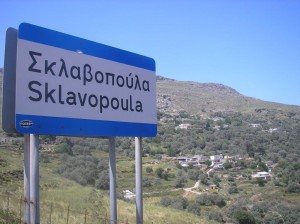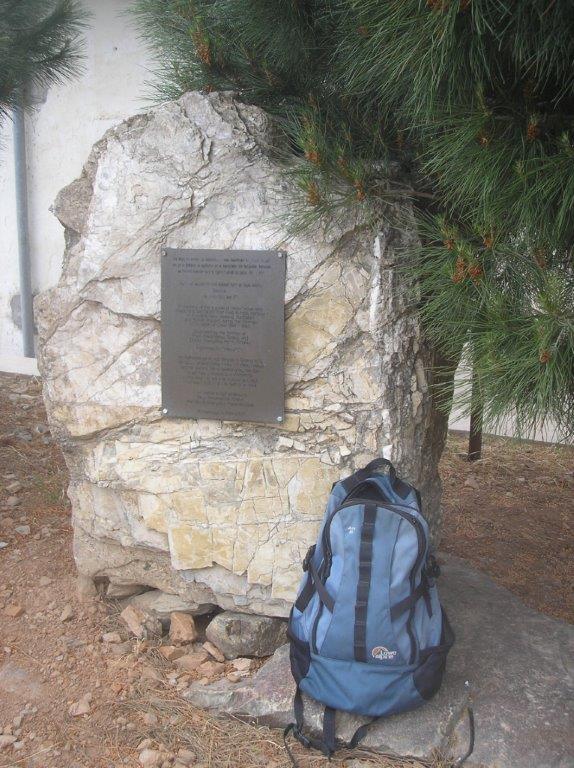“ It’s a long way, to Sklavopoula – it’s a long way, to go …”
Well, not too far, just over 18km through Koundoura and Ag. Theodoroi, slightly longer (and certainly more scenic) by way of Voutas, Lagadas and Kalamiou. At a height of almost 700m above sea level, Sklavopoula is high enough to escape the heat of summer, and this walk, maybe in the early evening after a day on the beach, is very special. Park beside the main church of Ag. Athanasios, at the road junction to Elafonisi (signed), and close to the small village cafeneion. Set off along the Elafonisi road, soon with Maniatiana below left, a panoramic view to the south, and the radar station another 300m above you.
A little further on, in the few houses of Papadiana, look out for a plaque on the wall.
This was unveiled in May 2006, during a pilgrimage to Crete by New Zealand war veterans to mark the 65th Anniversary of the Battle of Crete, a visit largely initiated and organised by Manos Nathan, of mixed Cretan and New Zealand ancestry. Inscribed in Greek, English, and Maori, the plaque reads :
In memory of the people of Sklavopoula who risked
and sacrificed their lives to help, harbour and protect
New Zealand, Australian and British soldiers during
the German occupation of Crete, 1941 – 1944.
Dedicated by the families of
Papa Alexandrous Torakis
Dr. Evangelos Papandonakis
Pilgrimage to Crete May 2006
One of the soldiers who found refuge and friendship in Sklavopoula was Ned Nathan, a ‘Kiwi’ serving with the 28th Maori Battalion. Severely wounded by bullets and shrapnel in his hip and eye (which he later lost) whilst defending Maleme airfield, Nathan was boarded on a boat evacuating the injured to Egypt. During the mayhem, the vessel was attacked by German fighter aircraft and sunk off Kastelli. One of few to survive, Nathan swam ashore, evaded German patrols and began the long walk towards Chora Sfakion, aided by Greeks with a donkey, hoping to be taken off the island by the Royal Navy. But above the port, they saw it under German control, and the last ships gone. Utterly exhausted by the journey and his wounds, malaria and gangrene, Nathan collapsed.
When he fully regained consciousness two weeks later, he was in the remote Selino village of Sklavopoula, being treated by Dr. Papandonakis, and looked after, and slowly nursed back to health by his niece, Katina Toraki, a young schoolteacher and the daughter of the village priest. In the following months, Nathan and others (hiding in nearby villages of Moustakos, Vothiana and Lagadas) made unsuccessful attempts to leave Crete on small boats from Elafonisi, and from Stomio/Mesara bays on the west coast, hoping to reach North Africa. But at Christmas & New Year 1941/42 they were still at Sklavopoula, where ….
“with music from an ancient gramophone, Ned Nathan played a banjo, someone else
played a mouth organ, and everyone joined in dances popular in the western world at
that time. This was the only time escapers danced with Cretan girls, or held them in
their arms. Strict local customs prohibited such close contact.” *
In 1942 Nathan was betrayed to the Gestapo, arrested, interrogated, badly beaten and almost shot as a spy. Becoming ill with malaria in Aghia prison, Chania, he was transferred to Athens, and from there to a POW camp in Germany, from where he made unsuccessful escape attempts. During this time his thoughts were with Katina in Crete, aided by occasional correspondence.
From Stalag 334 on the German/Polish border, Nathan was repatriated to England, then given permission to travel to Crete, where he was re-united with Katina, and they were married at Sklavopoula in October 1945. And from there, via Athens and Egypt, to New Zealand – home for Ned, and for Katina a journey to the other side of the world. Settling near Wellington, North Island, they raised a family and built up a successful business. Ned Nathan died in 1987, and Katina, his wife for over forty years, in 1996. And Manos Nathan, one of New Zealand’s leading ceramic artists, and who designed the plaque, is of course their grandson.
If this story has left you too emotional, return to the village and recuperate with a cool drink in the cafeneio.
To extend the walk (by c. 2 hrs), continue along the Elafonisi ‘road’ (becoming rougher, never attempt to drive there), turn sharp left before Sfakia, seemingly deserted, and drop down to the lonely church of Ag. Paraskevi.
The deep gorges seen from the track all look inviting and “explorable”, though every one leads into the Ropanas Ravine which exits at Krios beach (ref. “Explore” August 2011). At the church (unexeptional, but will provide shelter from the sun or rain), fork left, on a track which leads via several ‘gates’, all easily opened, to a final climb to join the ‘main’ road just 400m below Sklavopoula.
Footnotes
To conclude this fascinating story ; after the 2006 ceremony in Sklavopoula, the group drove down to Paleochora, where they enjoyed a Cretan meal and hospitality of the Petritakis family at the ‘Oriental Bay’ taverna. In 1952, Katina’s sister Esther had emigrated to New Zealand, where she met, and the next year married Stavros Petritakis (who was ‘sponsored’ in NZ by Frank Grover, a “Kiwi” escapee hidden and sheltered during the occupation by the Petritakis family in a cave above Spaniakos.) Others of the family moved to New Zealand, but some later returned home to Crete, including Stavros’ nephew, Yiannis, and his wife Thalia, who now run the popular and beautifully situated “Votsalo” cafe at our Chalikia (‘stony’) beach. Thalia talks warmly of Ned (“ a really lovely man”) and Katina (“a very clever woman.”) And not only are Yiannis, Thalia and their family very good friends, but are also my near neighbours in Spaniakos.
The Nathan family have declined all offers to make a film of their story, but assisted Patricia Grace with the research for her book, “Ned & Katina – A True Love Story”, published in 2009.
* Quotation from “Vasili – the Lion of Crete” by Murray Elliott (1987)










8 comments
Skip to comment form
A very fascinating lives story, thanks Bob. Makes us realise what a fortunate generation we are. Hope you are weathering the financial storm OK.
Thank you Bob for telling me to look this up this morning at The Votsalo. Fascinating as it puts present day Paleochora in touch with its pastl.
Really fascinating Bob, would love to read the book – do you have a copy? Olga
Manos was one of Ned and Katina’s sons, not a grandson.
Sfakia the seemingky desserted town before elafonisi is my fathers home and where my grand father was born.
Thanks for your story, very touching.
From Toronto Canada
My great grand father was born in sklavopoula in 1869. SFAKIA TO BE EXACT. Not the big Sfakia, the Little sfakia so its known,
Kalimera Bob, about the beautiful and quaint Kafenio Aposperida of Jannis and Georgia in Sklavopoula there is a photo book. “Cafe Taverna Sklavopoula” by the Swiss photographer Jürg Waldmeier.
Many greetings from Hamburg, kv
Thank you, Bob
For everything